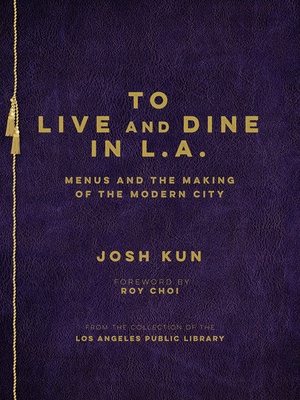
Book of the day > TO LIVE AND DINE IN L.A: Menus and the Making of the Modern City
Book of the day > TO LIVE AND DINE IN L.A: Menus and the Making of the Modern City by Josh Kun. Angel City Press. “In its fourth book collaboration with the Los Angeles Public Library and the Library Foundation of Los Angeles, Angel City Press releases To Live and Dine in L.A.: Menus and the Making of the Modern City by Josh Kun. With more than 200 menus--some dating back to the nineteenth century--culled from thousands in the Menu Collection of the Los Angeles Public Library, To Live and Dine in L.A. is a visual feast of a book.
In his detailed history, author Josh Kun riffs on what the food of a foodie city says about place and time; how some people eat big while others go hungry, and what that says about the past and now. Kun turns to chefs and cultural observers for their take on modern: Chef Roy Choi sits down long enough to say why he writes "some weird-ass menus." Pulitzer Prize-winning critic Jonathan Gold looks at food as theater, and museum curator Staci Steinberger considers the design of classic menus like Lawry's. Restaurateur Bricia Lopez follows a Oaxacan menu into the heart of Koreatown.
The city's leading chefs remix vintage menus with a 21st-century spin: Joachim Splichal, Nancy Silverton, Susan Feniger, Ricardo Diaz, Jazz Singsanong, Cynthia Hawkins, Micah Wexler, Ramiro Arvizu and Jaime Martin del Campo cook up the past with new flavors. And, of course, the menus delight: Tick Tock Tea Room, Brown Derby, Trumps, Slapsy Maxie's, Don the Beachcomber, and scores more.
Kun tackles the timely and critically important topic of food justice, and shows how vintage menus teach us about more than just what's tasty, and serve as guides to the politics, economics, and sociology of eating. America is a dining-out nation, and our research indicates that L.A. has long been one of its top dining-out towns. The Library's collection is a living repository of meals past, an archive of urban eating that tells us about the changing historical role of food in the city, which is to say it tells us about just about everything that food touches: economics, culture, taste, race, politics, architecture, class, design, industry, gender, to name just some of the themes that recur on menu pages."